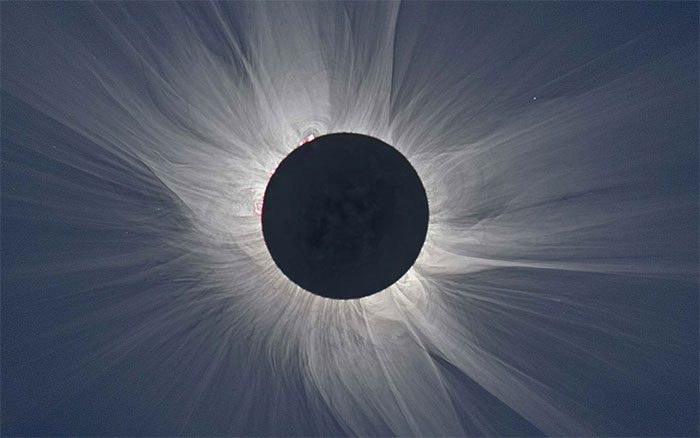Human understanding of the Sun has expanded significantly in recent times, yet there remain mysteries that we hope to decode in upcoming research.
Since we launched space probes, humanity’s knowledge of the Sun has increased exponentially.
We observe the Sun in new wavelengths, studying it through ultraviolet and X-rays, which has helped uncover many new aspects of our star.

We know a lot about the Sun, but there are 3 secrets still “challenging” scientists (Photo: Javier Zayas/Getty Images).
Many of the mysteries that once puzzled us have been explained, but there are still secrets that scientists are striving to unravel, including three major questions regarded as the missions of upcoming flights.
1. The Temperature Issue in the Corona
The outermost layer of the Sun’s atmosphere is called the corona, which has a temperature of about 1 million degrees Celsius. In contrast, the surface of the Sun, known as the photosphere, is much cooler at approximately 5,500 degrees Celsius. At first glance, this is quite perplexing.
If the energy in the Sun’s atmosphere is generated by the Sun itself, then why is the corona hotter than the surface of the Sun?

We can see the corona during a total solar eclipse (Photo: Miloslav Druckmüller, Shadia Habbal, Peter Aniol, Pavel Starha).
A common analogy to explain this is as follows: If we compare the Sun to a campfire, when the fire provides heat, you would feel the air far from the fire cooler, not hotter.
However, this analogy is not actually applicable as it misrepresents the accurate definition of temperature in physics.
In physics, temperature is defined as the amount of energy contained within the atoms that make up a substance. For example: the air around you; if the air’s atoms vibrate with a lot of energy, the air will be warm. If the atoms vibrate less, the air will be cooler.
This definition, however, does not consider density. If the air is denser because there are more atoms at the same temperature, the temperature of the air does not change. What changes is the energy of the air surrounding us.
Thus, in the case of the Sun, the corona is hotter but much less dense than the surface of the Sun. On the other hand, the surface is cooler but has a much higher density. As a result, even though the temperature of the photosphere is lower, the total energy remains higher.
Yet, despite knowing that the corona’s heat is due to higher energy in the photosphere, this still does not address the issue of how the corona radiates heat. The mystery remains as to how energy is transferred from the Sun’s surface to its atmosphere.
There are many theories regarding this issue, but what we have observed still provides no definitive evidence.
2. The Sun’s Internal Dynamics and Solar Cycles
The Sun’s activity increases and decreases in an 11-year cycle. At the peak of activity, sunspots and solar flares occur in abundance. During the minimum phase, the Sun remains “quiet” for months or even years.
The 11-year cycle is relatively predictable. However, the variations in the maximum solar activity from one cycle to another can be significantly different. Some cycles have maximum solar activity that is double that of others.

The progression of sunspot numbers over solar cycles as recorded by the National Oceanic and Atmospheric Administration (NOAA). Cycles 19 – 24 show very different maximum solar amplitudes (Photo: Space Weather Prediction Center, NOAA).
In general, we understand what causes solar cycles. Because the Sun rotates at different speeds at different latitudes, the Sun’s global magnetic field gradually increases and concentrates, leading to stronger magnetic activity.
Eventually, the magnetic field grows so strong that it disappears beneath the surface, revealing a minimal baseline magnetic field. Although we understand this process, the complex physical phenomena that govern the Sun’s magnetic field from within, known as the Sun’s internal dynamics, and why these internal dynamics cause an 11-year cycle with varying maximum levels, remain inadequately explained.
3. Predicting Solar Storms and Solar Flares

A solar storm occurring on the far side of the Sun on July 23, 2024 (Photo: Helioviewer.org).
Solar storms and solar flares are key factors that cause space weather, specifically the Sun’s impact on the near-Earth environment, which can lead to issues for power grids, satellite communications, and radio signals.
Worldwide, dozens of space weather forecasting stations continuously issue predictions to warn about potential disruptions caused by solar activity. These forecasting agencies do a commendable job, but they are still limited by the data collected and our limited understanding of the factors that trigger solar storms and solar flares.
Currently, we still predict these phenomena based on probability and reaction. We can identify when they are likely to occur, but we cannot pinpoint the exact timing.
To improve our predictions, we first need to understand the complex processes that cause these phenomena at a very small scale. This is an in-depth issue that scientists are focusing on intensely.


















































